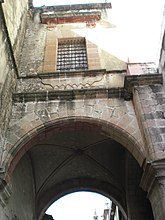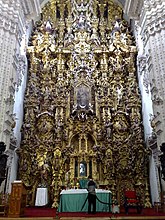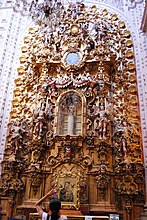Church of Santa Prisca de Taxco: Difference between revisions
| Line 69: | Line 69: | ||
File:Templo de Santa Prisca (Taxco - Mexico) (28001689088).jpg|Roof |
File:Templo de Santa Prisca (Taxco - Mexico) (28001689088).jpg|Roof |
||
File:Parroquia de Santa Prisca Taxco detalle superior de fachada.JPG|Upper facade |
File:Parroquia de Santa Prisca Taxco detalle superior de fachada.JPG|Upper facade |
||
File:The Martyrdom of Saint Prisca (1760) by Miguel Cabrera.jpg|''The Martyrdom of Saint Prisca'' (1760) by [[Miguel Cabrera (painter)|Miguel Cabrera]]. Located inside.<ref>{{cite web|url=http://52.183.37.55/artworks/9138|title=EL MARTIRIO DE SANTA PRISCA SANTOS|author=Miguel Cabrera|website=ARCA Arte Colonial}}</ref> |
|||
</gallery> |
</gallery> |
||
Revision as of 18:58, 13 November 2022
| Church of Santa Prisca de Taxco | |
|---|---|
 The façade | |
 | |
| Location | Taxco |
| Country | Mexico |
| Denomination | Roman Catholic Church |
| History | |
| Founded | 1758 |
| Architecture | |
| Style | New Spanish Baroque |
| Specifications | |
| Materials | Stone |
The Parroquia de Santa Prisca y San Sebastían, commonly known as the Church of Santa Prisca, is a colonial monument located in the city of Taxco de Alarcón, in the southern state of Guerrero, Mexico, built between 1751 and 1758. It is located on the east side of the main plaza of Taxco.[1]
The construction was ordered by José de la Borda, one of the most prosperous mine owners of the region of Taxco in the 18th century. From 1758 to 1806, the temple was the tallest building in Mexico, but was surpassed by the Church of Our Lady of Mount Carmel in San Luis Potosí City.
Construction

The church was built between 1751 and 1758 by José de la Borda (ca. 1700–1778), who had made a great fortune in the silver mines surrounding the town. Despite his wealth, however, the opulence of the church nearly bankrupted him.[2] The construction of the church of Santa Prisca in Taxco lasted 15 years and was aimed at creating a space where the priest Manuel de la Borda--son of José de la Borda, benefactor and founder of the parish--could officiate mass. The architectural design was provided by the French architect Diego Durán and the Spanish Cayetano Sigüenza. The altars are work also of the Spanish Isidro Vicente and Luis de Balbás.
Although he had arrived in Taxco only about thirty-five years before the construction of the Santa Prisca temple, José de la Borda was already one of the most important figures in the mineral, which is why the Archbishopric of Mexico allowed him to erect the parish your entire taste.
Description
The parish is located in a small hollow with respect to the rest of the city of Taxco artificially leveled. It has a Latin cross plan, with a side nave that serves as a chapel for the altar of the Souls and a tribune on a street with Gothic ribbed vaults with tiercerons with a decorated main key that camouflages access to the Sagrario (sanctuary). It has two twin towers in the Churrigueresque style and a chapel decorated with Talavera azulejos, characteristic of New Spanish architecture.
In this way, it is seen how the work has a great verticalist and dominant sense. The high Churrigueresque-style towers were very well crafted in their upper part to leave intact the plinth that acts as a visual buttress to frame the portal of the altarpiece. This is how the front has a language of architectural composition, typical of the time, with cylindrical columns in the lower part and twisted columns in the upper part.
Santa Prisca has nine floor-to-ceiling altarpieces, worked in wood and covered with gold leaf. The style of the altarpieces forms a unit with the architectural ensemble, that is, it is a sample of mid-18th century New Spanish Baroque. The main altarpiece is dedicated to the Immaculate Conception and the patron saints of the city of Taxco de Alarcón: Saint Prisca and Saint Sebastian. It looks like a cascade of superimposed carvings where the tectonic and compositional structure is lost, leaving the whole that wants to be shown as a whole instead of being divided into parts. In the chapels of the transept of the temple there are two other important altarpieces, one dedicated to the Virgin of Guadalupe and the other to the Virgin of the Rosary.
The central themes of the construction are: the patron saint Saint Prisca, Saint Sebastian, the evangelists, the shells (which symbolize the baptism of Jesus), the laurel leaves (which symbolize the triumph of faith) and the grapes, which represent the blood of Christ. Inside there are paintings by Miguel Cabrera, called "the divine", an Oaxacan painter born in the 17th century, to whom José de la Borda commissioned the paintings that decorate the building.
In 2010 the parish archive was organized where it was found that the oldest document dates from 1598.
Legend of Santa Prisca
There is a legend associated with the Santa Prisca Church. While it was in construction, José de la Borda left Taxco on business to Guanajuato, leaving construction work to the builders. Soon after Borda left, the sky filled with black clouds and cold winds struck the streets, whistling through the towers of the unfinished church. The dark and cold terrified the workmen as the large storm approached. Suddenly a large bolt of lightning struck showing an undefined black silhouette that was swooping down on the church. Then it struck the cupola of the church, lighting it brilliantly. All of the tile covering the cupola began to shine with strange lights, allowing the inscription “Gloria a Dios en las alturas y paz en la tierra a los hombres de buena voluntad” (Glory to God in the Highest and peace on earth for men with good will) to be seen clearly. The whole town got down on their knees to pray, fearing that angry demons would destroy the church. Floating around the church were flashes of light and above the church appeared a beautiful woman who, smiling and with a peaceful face, caught the following lightning bolts in her hands.[3]
Gallery
-
Interior of the temple, Templo de Santa Prisca de Taxco.
-
The passageway to the Sagrario on Calle del Arco.
-
Choir detail.
-
Altarpiece.
-
Reredos
-
Reredos
-
Sacristy furniture.
-
Dome.
-
Church of Santa Prisca de Taxco in 1919.
-
Church of Santa Prisca de Taxco in 1930.
-
Main altar of the Church in 1908. INAH.
-
Interior of the Church of Santa Prisca in 1920.
-
Roof
-
Upper facade
-
The Martyrdom of Saint Prisca (1760) by Miguel Cabrera. Located inside.[4]
See also
References
- ^ "El brillo de Taxco". Mexico Desconocido Guerrero El Destino del Mundo (in Spanish). 135. Mexico City: Grupo Editorial Impresiones Aéreas: 77–84. May 2007. ISSN 0188-5146.
- ^ Allen, Jim; Jan McHargue. "Silver, Saints, and Sinners: Semana Santa in Taxco, Mexico". Mexconnect. Retrieved 2009-08-26.
- ^ "Enciclopedia de los Municipios de Mexico-Guerrero:Taxco de Alarcón" (in Spanish). Retrieved 2009-08-26.
- ^ Miguel Cabrera. "EL MARTIRIO DE SANTA PRISCA SANTOS". ARCA Arte Colonial.
- Buildings and structures in Guerrero
- 18th-century Roman Catholic church buildings in Mexico
- Tourist attractions in Guerrero
- Roman Catholic churches completed in 1758
- 1750s establishments in Mexico
- 1758 establishments in the Spanish Empire
- Spanish Colonial architecture in Mexico
- Baroque church buildings in Mexico















![The Martyrdom of Saint Prisca (1760) by Miguel Cabrera. Located inside.[4]](http://upload.wikimedia.org/wikipedia/commons/thumb/0/0f/The_Martyrdom_of_Saint_Prisca_%281760%29_by_Miguel_Cabrera.jpg/322px-The_Martyrdom_of_Saint_Prisca_%281760%29_by_Miguel_Cabrera.jpg)